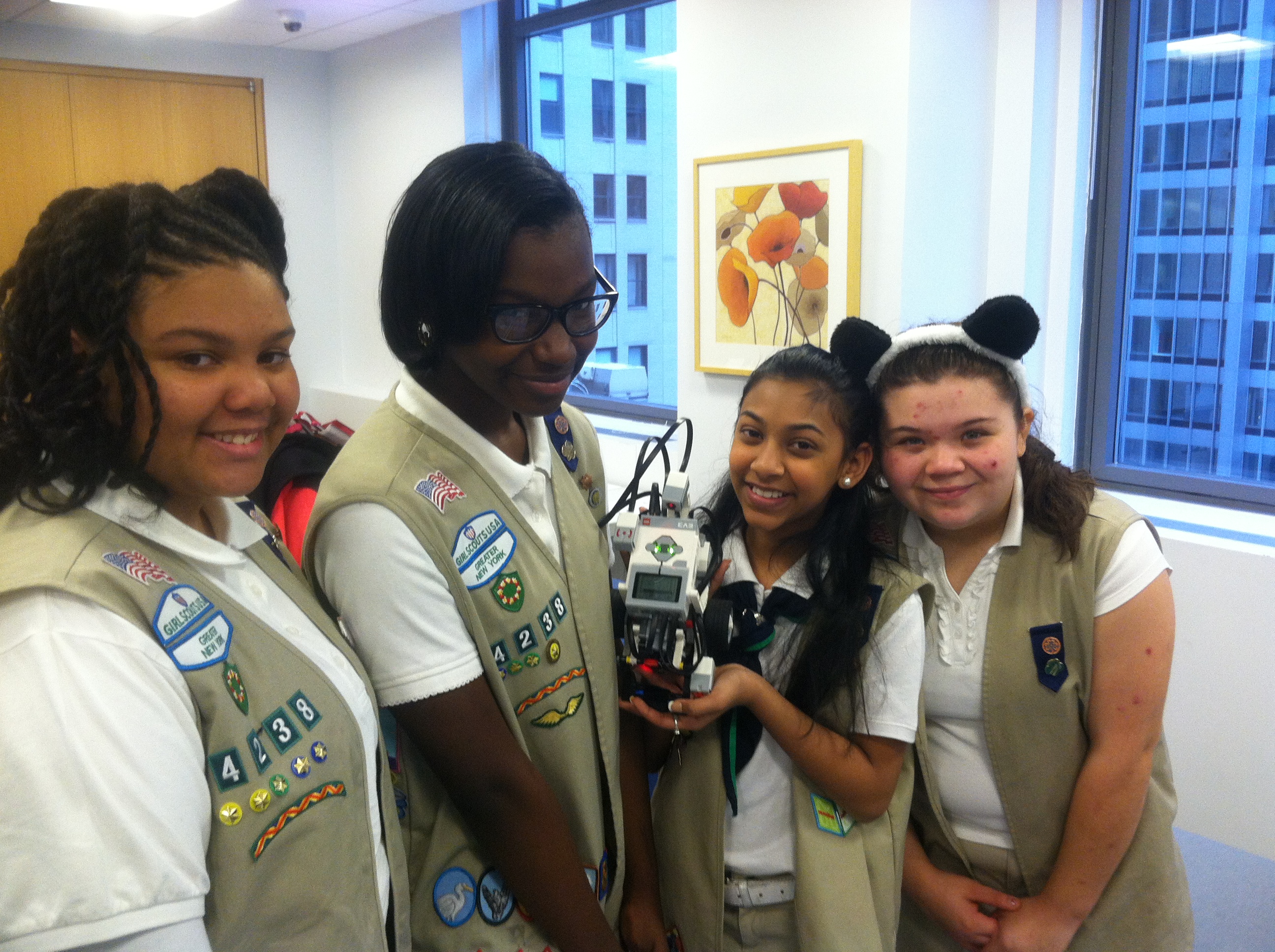
Girl Scouts of team Cadet Super Girls — Robyn Murphy, 12, Lauren Hedge, 12, Alyssa Dass, 11, and Brianna Ortiz, 11 — show off their robotic contraption, Miracle Bot.
BY COLIN MIXSON |
These girls are more than meets the eye.
At their Downtown headquarters in the Trump Building at 40 Wall St., the young ladies of the Girl Scouts of Greater New York are designing, building, and programming cybernetic contraptions for robotics competitions. The program is part of an effort by the venerable organization to prepare girls for the future by getting them involved early in the so-called S.T.E.M. fields of science, technology, engineering, and math.
“We’re 103 years old, and many people think of Girl Scouts in its earlier days, but we’re constantly adjusting to respond to how the girls are evolving,” said Tomika Rodriguez, director of program development for the city’s Girl Scouts program. “Women have this path ahead of them in terms of the S.T.E.M. fields that can lead to economic independence. That’s a focus for us, and our council as a whole, and S.T.E.M. is one way to that.”
The Girl Scouts’ budding roboticists are participating in the International Lego League tournament, which challenges young makers with solving real-world problems using the world’s largest toymaker’s Mindstorms line of motors, wheels, and interlocking plastic bricks.
This year’s Lego League program, themed “Trash Trek,” focuses on tackling the challenges surrounding waste removal and recycling — such as collecting garbage, sorting trash, and even returning displaced species to their natural habitats — each of which is assigned a point value based on the level of difficulty.
“It gives you an array of options, and the girls decide based on their capabilities … what specific challenges they’re going to complete,” said Rordiguez.
But the trick isn’t just building a machine physically capable of completing the tasks — it’s teaching it how to do so. The girls must not only build the bot, but program it too. Once it’s out of the gate, the girls can’t touch their machine, and it’s up to their coding skills to ensure that their creation completes its designated chore.
“The key is they’re building coding skills and learning the building blocks of what the computer can understand,” said Sarah Pooley, the scouts’ manager of youth leadership and volunteer support.
The process of taking a robot from design to completion is long and fraught, with numerous mishaps.
Bots on trash pickup duties may by accident get caught up in a demolition routine, or the makers may misjudge the distance necessary to deliver an “octo-chick” — a Lego octopus-chicken hybrid serving as one team’s indigenous animal — to its natural habitat, leaving it on the beach instead of in the ocean.
But the routine of trial and error cements important analytical and problem solving skills, and promotes a healthy sense of teamwork amongst peers, according to one scout.
“We run into problems a lot,” said 11-year-old scout Alyssa Dass, a member of robotics team Cadet Super Girls. “But as a team. We work together, because there is no ‘I’ in team. We shout out ideas, vote on it, and pick the best idea. Then we do trials and runs, and it worked out pretty well.”
Once their contraptions are finally in working order, the girls then head into the arena of the NYC First Lego League, where their bots go head to head with other robots from teams throughout the city to determine whose machine is most proficient at the various tasks.
The New-York-based scouts have fielded three competitive robotics teams this year, all of which will be heading to the NYC First Lego League championship in March, an outstanding achievement in and of itself for girls who only started competitive bot-building this year, according Dass.
“It was very overwhelming,” she said. “We didn’t know what we were getting ourselves into because this was our first year of competitive robotics, and a lot of people were so prepared and had been here for years and we were just newbies.”
Now, as the girls put the finishing touches on their robots before the big event next month, one question lingers: will the endearing sight of green-vested girls selling cookies door to door endure, or are those young ladies even now engineering the means of their own obsolescence?
“With all three of our competitive teams advancing to the championship, robotic cookie deliveries may not be far behind,” Rodriguez mused.
































